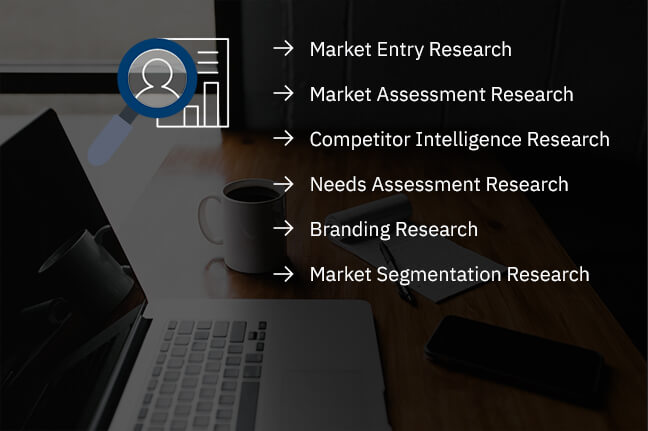Why is it important to target the right audience?

Although using the right market intelligence techniques will offer you far-ranging benefits by streamlining your intelligence process, the purpose of this article is to help businesses understand these market intelligence techniques to target the right audience.
Your target audience consists of people who are most likely to buy your product or service based on demographics, behavioral patterns, and lifestyle characteristics. By identifying and understanding this audience, businesses can tailor their messaging, refine their product offerings, and create campaigns that resonate.
Determining a target audience will ensure that your marketing efforts are focused and that you’re not chasing customers who have no intent or interest in buying your product/service. It also brings efficiency in your marketing strategy. According to Forbes, defining a target audience offers a good starting point to create messaging to drive marketing and sales. This messaging will then help you pitch your product or service in a way that guides your prospects through the sales funnel. Marketing strategies that put the needs and goals of their target audience front and center are more likely to be successful in persuading them.
Now that we know why targeting the right audience or customer base is important, let us get down to understanding the best market intelligence techniques to target the right audience.
6 essential marketing intelligence techniques to target relevant audience

The core goal of marketing intelligence techniques is to help businesses grow their presence and competitiveness. These techniques help teams gather marketing analysis, streamline decision-making, and gain clarity on market dynamics.
Here are six powerful and widely used market intelligence tools and techniques:
1. Market Entry Research
Market entry research is carried out by businesses looking to enter a new market or enter adjacent markets other than the ones they’re already established in. The intelligence gathered during such research is directed towards market understanding, and allows organizations to understand whether investing in a new market will be beneficial for them. Performing market entry research before entering a new market will help you determine the following:
– The demand for your particular product or service in the market
– The marketing channels that help supply your product or service to your consumers
– The market’s response to a new entrant
– Feedback from industry experts and associations
This market intelligence technique helps reduce risk by providing a data-backed market entry strategy. While it’s a traditional practice, using advanced market intelligence tools like Contify accelerates the process by automating data collection and insight delivery.
Request a 7-day free trial of Contify’s Market and Competitive Intelligence Platform here >>
2. Market Assessment Research
Market assessment research is usually more qualitative than quantitative. It is an evaluation that is done by an organization generally after a decision has already been made, such as launching a new product, or making a new investment or acquisition. Traditionally, market research was conducted through interviews and surveys with customers, competitors, and acquired businesses.
Today, most of this information can be found online and gathered using marketing intelligence techniques, and the rest can be acquired using online surveys. Market assessment research can also identify potential opportunities within your existing markets to increase your sales.
3. Competitor Intelligence Research
Competitor intelligence research is perhaps the most popular technique when using competitive intelligence techniques, the one most businesses are interested in. Every organization wishes to get an inside view of their competitor’s functioning, as well as their strengths and weaknesses so that they can use it to their advantage. In fact, competitor intelligence, also known as competitive intelligence, is seen as a different field of intelligence altogether. This is because of the diverse information this market research technique can provide; which includes understanding the market and market share, gaining insights on investment and expansion plans, pinpointing marketing strategies and measuring supplier performance; as well as customer sentiment, to name a few.
The sources for this type of marketing intelligence are abundant and include competitors’ websites, social media, online annual reports, news, review portals, job postings, discussion forums, focus groups, and the like. Competitive intelligence research is a treasure-trove of information that fuels better business decisions, and thus can be and should be performed as an ongoing process in your organization.
4. Needs Assessment Research
To be able to target the right audience, organizations need an assessment that will tell them what the customers in their target market need, as opposed to what they currently get. That’s what a needs assessment research is for. Investigating this gap in the market using marketing intelligence allows you to refine your product as well as marketing strategy to meet these needs.
Using a blend of quantitative market intelligence techniques and consumer feedback (surveys, interviews, etc.), businesses can reshape their offerings to align with unmet customer needs. Building your value proposition based on a needs assessment research will empower your decision-making capabilities, and ensure growth and longevity for your business.
5. Branding Research
Your brand defines how your customers perceive you. Branding research helps you understand brand awareness, market penetration, brand value, and loyalty.
- Effective marketing analysis techniques here include:
- Measuring brand recall
- Evaluating brand sentiment
- Comparing brand perception vs. competitors
This technique allows you to fine-tune your positioning and differentiate your identity in a crowded market.
In short, it will answer questions like – “What do customers think of your brand?”, “Do the customers know about your brand?”, “How well has your brand penetrated the market?”, and “Are your customers loyal to your brand?” Branding research thus allows you to assess both your brand, and that of your competition, to ascertain the strengths and weaknesses of both, and then make efforts to model your brand accordingly.
6. Market Segmentation Research
Market segmentation is the process of dividing a market into homogeneous sub-sections of customers, where any sub-section may conceivably be selected as a market target to be reached with a distinct marketing mix. At a broad level, it can be segmented based on consumer personal characteristics (that include geographic, demographic, socio-economic, psychographic) and consumer responses.
This is one of the most targeted types of market intelligence techniques, helping marketers tailor strategies and messaging to each segment. Not only that, it allows you to develop different strategies and tactics for the different segments. Market intelligence can help you gather quantitative data on your ideal customers, which can then be input directly into your digital and offline marketing strategy as well as product development. The end goal here, of course, is increasing revenue.
Market intelligence allows you to understand your target audience, and thus make informed decisions regarding your business, which is why it plays an indispensable role in all the above-mentioned research techniques. Finally, a word of advice – although target audiences can be clearly defined at a high level, in reality, a product or service can appeal to a variety of buyers who may have different needs and goals. Thus, it is advisable to take a more granular approach to target audiences and use the information gleaned from such research only as guidelines for your decision-making process.
Download M&CI Process Template
How to choose the appropriate market intelligence technique for your organization?

As you can see, there are numerous market intelligence techniques you can use depending on your organization’s nature and maturity. These techniques can help you do the following:
1. Enter a new market
2. Strengthen and defend your position in the market
3. Gain a competitive advantage over your competitors
4. Make an acquisition
5. Reinforce your brand
6. Differentiate your organization from your competitors
All of these will help you get your product/services to the right audience in some way or the other. Regardless of which technique you use, the key to success is in understanding your customers better than your competitors, and also understanding your key competitors’ mindset, strategy, and tactics.
Knowing the right market intelligence technique (or a combination of such techniques) for your organization depends on how good understanding you have about the pain points of your organization, especially within marketing and sales. The resources you have at your disposal will also determine how in-depth your research will be.
It also helps to assess the winning factors of your company’s value proposition. Insights, of course, are key to any market intelligence technique, so a well-functioning and effective market intelligence program is vital. Alternatively, a market and competitive intelligence tool, or software like Contify could work wonders for your organization by aggregating and delivering actionable insights to all the key stakeholders in your organization with relatively less effort than the manual gathering of market intelligence.
Conclusion
Market intelligence techniques help organizations envision strategies around the best course of action to take, depending on their position in the market. Using the insights gained from such techniques effectively, organizations can understand the competition and the market as a whole, avert mistakes, penetrate a market successfully, make investments or acquisitions with confidence, identify customers’ needs, determine market segmentation, build and improve their brand, reach their target audiences and finally increase profitability.
The right market intelligence technique along with the right tools are thus obligatory for the company to achieve all of its objectives, including reaching the right target audience:
-
Accurate customer targeting
-
Efficient marketing spend
-
Greater ROI
-
Faster time-to-market
Whether you’re just starting or refining a mature intelligence program, using proven marketing analysis techniques is non-negotiable. Platforms like Contify streamline these efforts, allowing teams to spend less time searching and more time acting on insights.
If you’re looking to align your strategy with real-time market insights, explore Contify’s powerful market intelligence platform for signing up for a 7-day free trial today.
Frequently asked questions
1. What are the most effective market intelligence techniques?
The most effective market intelligence techniques include market entry research, market assessment, competitor intelligence, needs assessment, branding research, and market segmentation. These types of market intelligence techniques help businesses make data-driven decisions by providing insights into customer behavior, market trends, and competitor strategies.
2. Why is market intelligence important for targeting the right audience?
Market intelligence enables businesses to identify and understand their ideal customer segments. By applying the right marketing analysis techniques, companies can tailor messaging, optimize campaigns, and ensure their products and services reach the right audience with minimal resource wastage.
3. How can branding research improve audience engagement?
Branding research, as a marketing intelligence technique, helps assess how your audience perceives your brand. It identifies brand awareness, recall, loyalty, and emotional connection. These insights allow you to fine-tune your messaging, tone, and visuals to better resonate with your audience and improve engagement.
4. Can market intelligence tools automate research and analysis?
Yes, modern market intelligence tools and techniques can automate data collection, aggregation, and analysis. Platforms like Contify streamline the process by continuously monitoring relevant sources of marketing intelligence and delivering actionable insights directly to decision-makers.



